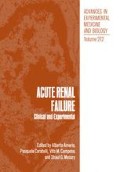Abstract
Several factors including hypoxia,lysomal enzymes release, endotoxins and kinins have been involved in the pathogenesis of ARF1. Among these, hypoxia represents the initiating event of a series of biochemical reactions which culminate in the production of oxidative radicals. The most important are the superoxide ions (O2 −) and the free radicals which result from their interactions with other molecules. These substances can injure cells by peroxidating the lipid membranes. The organism however has efficient enzymatic and non enzymatic systems which can oppose and control the production of free radicals and superoxide anion. These systems are represented by superoxide dismutase, catalase and glutathione peroxidase which can detoxicate the SR, the hydrogenperoxide and the lipid peroxides3,4 Among the other physiological scavangers glutathion vitamin E and C, cysteine and probably uric acid have great importance5. The biological sequence occurring during ischemia is schematically represented in Fig.1. During hypoxia there is a rapid consumption of ATP with a rise in intracellular AMP concentration, subsequently metabolized to adenosine, inosine and finally hypoxanthine,which accumulates in the ischemic tissue and represents the substrate of xanthine(X) dehydrogenase and X- oxidase Certain authors postulate that the fundamental biochemical phase during hypoxia, is represented by X-dehydrogenase activity, while in the reoxygenation phase the activity of Xoxidase prevails, producing hydrogen peroxide and SR, responsible for the maintenance of the ischemic damage.
Access this chapter
Tax calculation will be finalised at checkout
Purchases are for personal use only
Preview
Unable to display preview. Download preview PDF.
References
J.M. McCord, Oxygen-derived free radicals in post-ischemic tissue injury, New Eng.J.Med 312: 159 (1984).
F.Z.Meerson, V.E.Kagan, Y.P.Kozlov, L.M.Belkima and Y.V.Arkhipenko, The role of lipid peroxidation in pathogenesis of ischemic damage and the anti-oxidant protection of the heart, Basic Res.Cardiol. 77: 465 (1982).
W.A.Pryor, The formation of free radicals and the consequences of their reactions in vivo, Photochem.Photobiol. 28: 787 (1978).
B.E.Leibovitz, B.V.Siegel, Aspects of free radical reactions in biological system: aging, J.Gerontol. 35: 45 (1980).
B.N.Ames, R.Cathrat, E.Schwiers, P.Hochstein, Uric acid provides an antioxidant defense against oxidant and radical-caused aging and cancer: a hypothesis, Proc.Natl.Acad.Sci. USA 78, 6858 (1981).
M.Shlaper, P.F.Kane, V.Y.Wiggins, M.M.Kirsh, Possible role for cytotoxic oxygen metabolites in the pathogenesis of cardiac ischémic injury, Circulation 66:85 suppl. 1 (1982).
J.R.Stewart, W.H.Blackwell, S.L.Crute, V.Loughlin, M.L.Hess, L.S. Greenfield, Prevention of myocardial ischemia: reperfusion injury with oxygen free radical scavengers, Surg.Forum 33: 317 (1982).
A.S.Casale, G.B.Bulkley, B.H. Bulkley, J.T. Flaherty, V.L.Gott, T.S. Oxygen free radical scavengers protect the arrested, globally ischemic heart upon reperfusion, Surg.Forum 34: 313 (1983).
D.E.Oken, Acute renal failure (vasomotor nephropathy): Micropuncture studies on the pathogenesis mechanisms, Ann.Rev.Med. 26: 307 (1975).
N.Parekh, U.Veith, Renal hemodynamics and oxygen consuption during post-ischemic acute renal failure in the rat, Kidney Intern. 19: 306 (1981).
J.M.McCord, I.Fridovich, The reduction of cytochrome C by milk xanthine-oxidase, J.Biol.Chem. 243: 5753 (1968).
C.E.Jones, J.W.Crowell, E.E.Smith, Significance of increased blood uric acid following extensive hemorrhage, Am.J.Physiol. 214: 1374 (1968).
D.A.Parks, G.B.Bulkley, N.D.Granger, S.R.Hamilton, J.M.McCord, Ischemic injury in the cat small intestine: Role of superoxide radicals, Gastroenterology 82: 9 (1982).
Author information
Authors and Affiliations
Editor information
Editors and Affiliations
Rights and permissions
Copyright information
© 1987 Plenum Press, New York
About this chapter
Cite this chapter
Faedda, R., Satta, A., Branca, G.F., Turrini, F., Contu, B., Bartoli, E. (1987). Superoxide Radicals (SR) in the Pathophysiology of Ischemic Acute Renal Failure (ARF). In: Amerio, A., Coratelli, P., Campese, V.M., Massry, S.G. (eds) Acute Renal Failure. Advances in Experimental Medicine and Biology, vol 212. Springer, Boston, MA. https://doi.org/10.1007/978-1-4684-8240-9_8
Download citation
DOI: https://doi.org/10.1007/978-1-4684-8240-9_8
Publisher Name: Springer, Boston, MA
Print ISBN: 978-1-4684-8242-3
Online ISBN: 978-1-4684-8240-9
eBook Packages: Springer Book Archive

